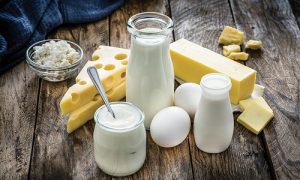Contents
For someone who is lactose intolerant, maintaining a well-balanced diet can be a challenging matter to handle. Luckily, there is more than one way to cope with this condition. By following a well-balanced lactose intolerance diet, you can manage your condition without experiencing its unpleasant side effects. Since there is no cure for being lactose intolerant, you can use these strategies and combine with home remedies to take control of your lifestyle.
This article will help you take a closer look at which foods you should consume and which ones you need to stop as a part of your lactose-free diet.
Overview: Lactose Intolerance
Lactase deficiency, also known as lactose intolerance, is a condition in which the body cannot absorb lactose, a natural sugar present in milk and other dairy products. Lactose intolerance is more common in adults than in children because adults’ bodies are less dependent on milk than children’s bodies are. Therefore, an adult’s body produces less lactase, the enzyme responsible for breaking down lactose.
In most cases, lactose intolerance is not harmful. However, improper management of this deficiency can lead to unpleasant results, not to mention the embarrassment that could happen when you’re outdoors. Undigested lactose remains in the intestine where bacteria break it down, inducing gas, bloating, nausea, and diarrhea.
How Do I Manage Lactose Intolerance?
A hydrogen breath test is a standard diagnostic procedure to check for lactose sensitivity. Usually, a normal result will show only a trace of hydrogen gas in the breath. However, a lactose-intolerant individual will retain undigested lactose in their intestine, producing various gases, including hydrogen.
If you’re lactose intolerant, experts believe you do not necessarily have to exclude all dairy products from your intake. In the past, it was a common practice for people with lactose intolerance to eliminate dairy products from their diet completely. However, many research studies have disproven this theory.
Most people with lactose intolerance can consume small portions of dairy products without experiencing symptoms. Up to the present time, medical professionals advise the use of cheese, tofu, and even milk as a part of your lactose-free diet and recovery plan.
Lactose Intolerance Recovery Plans
Once your doctor finds out your lactose intolerance levels, he will create a treatment plan to help manage your condition. Fortunately, it is now possible to adopt a lactose-free diet plan to alleviate symptoms. Some people may also opt to follow a lactose-reduced diet to decrease their dairy consumption.
Your lactose intake should depend on your condition. While most medical experts determine acceptable amounts by trial and error, it is vital to keep in mind some techniques for dairy management.
Lactose Reduced Diet Recovery Plan

Aside from lactose, calcium and vitamin D are also present in milk and dairy products. These are excellent sources necessary to maintain strong bones. Hence, removing dairy products from your diet can lead to a series of nutritional problems. Consuming less than your daily recommended intake could affect your bone strength and result in fractures.
Most importantly, recent studies have shown that it is possible to build up lactose tolerance over time. This theory suggests the gradual change in an individual’s intestinal bacteria, making it easier to digest lactose.
How Do I Maintain A Lactose-Reduced Diet?
Divide and Conquer
The first thing that your physician or dietician would suggest is to divide your daily lactose intake. Spacing out your lactose intake during the day prevents your digestive system from being overwhelmed. By reducing your consumption for up to four to eight ounces per serving, you allow your organs to break down and absorb nutrients that help ease the metabolic process.
Addition to Meals
Solid food slows down metabolic action. By including lactose as a part of your meals, you will have extra time to allow a complete breakdown and absorption process. For example, adding a glass of milk along with your meal will work well with your diet.
Digestion Aids

Yogurt Products
Many yogurt preparations contain live and active cultures. It has a low lactose content and does not cause any issues. If you find milk products to be harsh on your metabolic reactions, perhaps a yogurt could help. The bacterial culture in a yogurt preparation is pre-digested, making it suitable for many people with lactose intolerance.
Lactose-Free Diet Recovery Plan
On the other hand, there are cases when a person’s lactose intolerance level is too high. In this case, a complete lactose-free diet is necessary. While it is a delicate balancing act to plan out a lactose-intolerant diet, it is best to eliminate dairy to prevent symptoms.
The basic principle of a lactose-free diet is the more dairy protein you cannot get, the more dairy-free products you need to include. Additionally, these products must be rich in calcium and other nutrients. Adult men and women need to achieve one gram of calcium per day, while women after menopause must aim for one thousand two hundred milligrams.
How Do I Prevent Hidden Lactose?
Perhaps one of the most critical aspects of maintaining a lactose intolerance diet is keeping an eye out for your food intake. There are many hidden sources of lactose in the food we eat. As a part of their overall ingredients, some products unnoticeably contain lactose, such as baked goods, creamy sauces, processed cereals, and powdered meals.
Since lactose can be present in unexpected places, you may want to read food labels carefully to stay away from these ingredients:
- Casein
- Whey
- Milk by-products
- Curds
- Non-fat dry milk powder
- Dry milk solids

Lastly, we must also keep in mind that certain ingredients such as lactic acid, lactate, and lactalbumin may sound identical to lactose, but they are entirely unrelated.
Wrapping it Up
Lactose intolerance is a complex condition that can take a toll on a person’s daily life. With the right balance of dietary lactose and dairy protein, you will succeed in getting the most out of your diet. To do so, you must pay attention to your intake and read more about food labels. Many ingredients, including fruits, vegetables, whole grains, proteins, and legumes, may be consumed as part of a lactose-free diet.
If you are worried that you are not getting enough calcium, vitamin D, and other essential nutrients in dairy, you can talk to your doctor about it. Consulting with a licensed dietitian will also help you get the appropriate treatment options.
References:
Lactose Intolerance.
https://www.betterhealth.vic.gov.au/health/conditionsandtreatments/lactose-intolerance
Sass, C. 5 Tips for Cutting Out Diary, According to a Nutritionist.
https://www.health.com/nutrition/cutting-out-dairy
Reyes, C. The Healthiest Diet for Lactose Intolerance.
https://www.everydayhealth.com/digestive-health/best-diet-for-lactose-intolerance.aspx
Calcium and Vitamin D
https://www.nof.org/patients/treatment/calciumvitamin-d/
